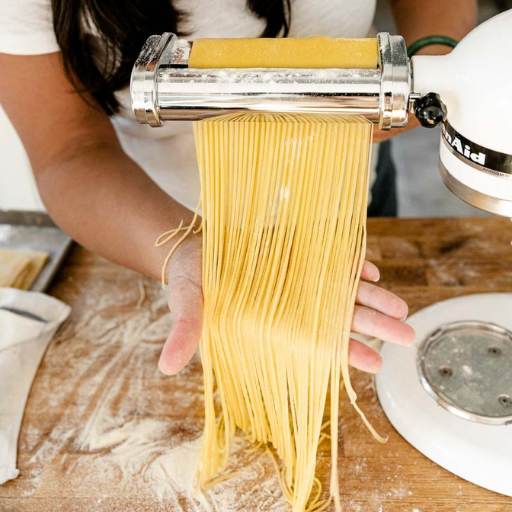We would like to give you a complete guide about the best pasta makers for 2024. It does not matter if you are an experienced cook or just a beginner who loves Italian cuisine. Cooking fresh pasta from scratch can improve your cooking skills and delight your taste buds. Thus, we have prepared many different pasta makers, which were thoroughly tested and reviewed – everything is done to help you make the right choice. We will discuss devices with manual control and those powered by electricity; features, usability, and quality of produced dough will also be discussed here. Let us show you our knowledge of this craft by advising you on choosing the perfect pasta maker for your needs!
What to Look for in a Pasta Machine?
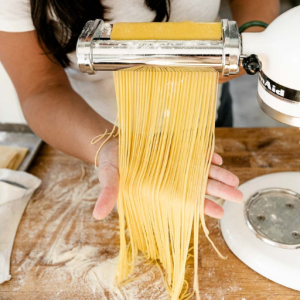
Image source: https://playswellwithbutter.com/
You should look at a few key features to ensure you have selected the suitable pasta machine. You must first determine what kind of machine it is – manual or electric – because this will affect how much effort is required and how much control there can be over the process of making pasta. Another thing that should be considered is whether or not there are adjustable thickness settings; with these, one can create different styles of pasta ranging from thin sheets for lasagna to thick doughs for fettuccine. Furthermore, it may also help if attachments are available: certain ones could enable users to produce various shapes like spaghetti or ravioli. Lastly but most notably in terms of convenience, ease-of-cleaning alongside durability should never be compromised, especially when purchasing any appliance; ideally speaking, a good quality machine ought to allow its parts to come apart quickly, thus making them easy to clean thereafter use while at the same time being made out strong materials such as steel so that they do not break easily even after frequent usage.
Types of Pasta Makers
There are three main types of pasta machines: manual, electric, and stand mixer attachments.
- Manual Pasta Makers: These pasta makers are controlled by hand turning a crank. They provide a traditional way of making pasta. The thickness of the pasta can be controlled using them, and they usually come with a few basic attachments for different shapes, too. Some physical effort is required in using these machines, but many cooks like it this way because of the tradition involved and because they can work at their own pace while making fresh pasta.
- Electric Pasta Makers: Electric pasta machines are best suited for saving time and energy. With just one button push, these devices will mix, knead, and roll out doughs used in making pasta, automating most parts of the process. There could be various settings on them or different kinds of attachments that allow users to easily create a wide range of pasta shapes without any stress. Although costly compared with other types mentioned earlier, if you love eating lots of pasta, the convenience offered here may justify such prices.
- Attachments for Stand Mixers: If you already have a stand mixer at home, then getting some useful add-ons would be a great idea, too! Such tools usually include rollers plus cutters so that people can make their very own fresh pasta right in the kitchen where they prepare meals daily—it’s like killing two birds with one stone. This option is functional besides saving space since you don’t require another separate machine meant explicitly for this purpose alone if you go with it.
Every kind has pros; therefore, consider your cooking style and space restrictions before settling on any type among these three categories.
Manual vs. Electric Pasta Maker
To make a decision between manual and electric pasta makers, the advantages and disadvantages of each should be considered. Often described as simple to use and versatile, manual pasta machines allow users to make pasta at their own pace, which can be gratifying for people who love getting their hands dirty in the kitchen. Nonetheless, this option requires more physical work and may consume much time. On the other hand, electric machines mix and roll dough faster than any other method without much effort from you. They are convenient, especially if you make pasta often or prefer not to use traditional methods. In conclusion, what matters most when choosing between these two options is your preference in terms of involvement; how much fun do you want to make fresh pasta with others involved?
Key Features of a Pasta Machine
To create a pasta machine, there are many things to take into account:
- Changeable Thickness Settings: This is important because a good pasta machine, such as thin lasagna sheets or thick fettuccine, should create different types of pasta.
- Materials that last: A stainless steel construction is preferred since it guarantees durability and ease of cleaning.
- Interchangeable Cutters: Some models come with various cutter attachments, which are used for shaping pasta into different forms, such as spaghetti, linguini, or ravioli.
- User Friendliness: Those who are new to this activity should choose machines with easy-to-understand controls accompanied by clear instructions on how best to use them during the pasta-making process. This will give them more enjoyment while doing it.
-
Suction Base and Stability: To ensure safety while cooking with such appliances, stability, together with the suction base, will significantly prevent slipping during use, thereby making cooking even more precise and safer.
With these points in mind, you can select the most suitable machine for your needs and culinary desires.
Comparing the Best Pasta Makers of 2024
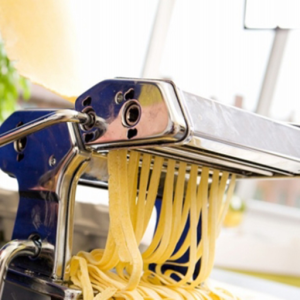
In 2024, there are many great pasta makers to choose from. They can be ranked by their performances, features, and user feedback.
- Marcato Atlas 150: This model is known for its strong construction and versatility. It allows users to easily make different thicknesses of pasta and various shapes. Made from stainless steel, it is durable while working smoothly, which suits both beginners and experienced cooks.
- KitchenAid Pasta Roller Attachment: This attachment is designed specifically for KitchenAid mixers. It adds another function to your mixer by enabling you to roll out and cut pasta without effort. You can adjust settings depending on what you need, and it always works reliably, so if you already own other appliances made by KitchenAid, this could be the most convenient choice for you.
- Pasta Machine by Imperia: Many people have appreciated the simplicity yet effectiveness of this manual machine when making their own fresh noodles or spaghetti at home. It is built strong enough using long-lasting material and offers adjustable thickness for a traditional method combined with modern convenience.
- Electric Pasta Maker by Philips: If you want everything done automatically, try the electric pasta maker from Philips. It’s a game changer that mixes and kneads dough instead of you, so the process becomes quick with less involvement required from your side, especially when running short on time—just press the button! Besides producing many different shapes within seconds, such machines are top-rated among busy housewives who prepare meals for large families every day after returning tired from work.
All four have something special about them, catering to various cooking styles or preferences; whether one prefers doing things manually or in an automated way, there will always be a suitable device among these options in 2024.
Marcato Atlas 150 Pasta Maker
The Marcato Atlas 150 Pasta Maker is a well-loved product on popular cooking websites because of its dependability and excellent performance. Some reviews point out the solid stainless steel build that guarantees strength and long life, making it a good investment for anyone who loves pasta. It has many thickness settings that can be adjusted to create different types of pasta, such as lasagna, fettuccine, or spaghetti, which users appreciate. Apart from this, the machine runs smoothly and can be easily cleaned, which are essential features for beginners and experienced chefs. While one of many pasta-making machines available in the market today, the Atlas 150 stands out as it combines traditional methods with modern design, thus appealing to those who enjoy artisanal cooking at home.
KitchenAid Pasta Roller Attachment
This multi-functional tool is designed to turn your KitchenAid stand mixer into a pasta-making machine. People love it because of its durability and user-friendliness when they want to roll out or cut fresh noodles effortlessly. They also appreciate that this device can make different kinds of pasta due to its adjustable thickness settings, which allow for ultra-thin sheets and thicker noodles. Besides being easy to use, it attaches easily to the mixer, enabling quick setup times, which inspire culinary experimentation; moreover, many reviewers mention how simple cleaning up after using it is, so even novices will find joy in making their delicious homemade pasta with this tool recommended by professionals.
Philips Pasta Maker Review
The Philips Pasta Maker is highly praised by chefs worldwide for its originality and efficiency. Automatic mixing and kneading are among the functions noticed by most reviewers, which means you can effortlessly produce fresh pasta with this machine. Different pasta shapes, such as spaghetti, penne, or lasagna, can be made thanks to various shaping discs in the package. What people like about it is that, besides other things, there is a built-in recipe book, so one never runs out of ideas on what kind of dish they should create using different types of noodles daily. Also, all parts are easy to clean and have a compact design, making them handy for any kitchenette. Thus, traditional methods will make homemade tasty pasta much faster than usual!
How to Use a Manual Pasta Maker to Make Fresh Pasta?
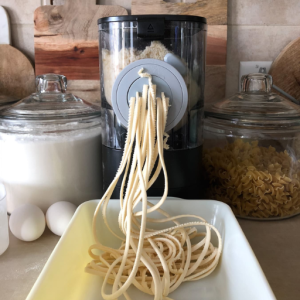
It is simple to make fresh pasta with a manual pasta maker. To start, mix flour and eggs until you get a smooth dough. Then, divide the dough into smaller pieces and slightly flatten one before feeding it through the pasta maker at its widest setting. You should narrow down the setting little by little as you pass it through, but ensure enough flour dusting on your dough so it doesn’t stick onto itself or any part of the machine. When the desired thickness is reached, change to a cutting attachment, shaping your pasta into whatever form, like fettuccine or lasagna sheets. Lastly, hang them up or lay them out somewhere on a floured surface where they can dry a bit before cooking them. Have fun making homemade pasta!
Preparing the Pasta Dough
To make pasta dough, you only need a few essential ingredients. Start with 2 cups of all-purpose flour and create a hole in the middle. Add three giant eggs and a pinch of salt for taste. Use a fork to gradually mix the flour with the eggs until you get a rough dough. Then, knead the dough onto a lightly floured surface for about 8-10 minutes until it is smooth and elastic. If the dough seems too dry, add some water; sprinkle more flour on top if it’s too sticky. Once kneaded, wrap it in plastic wrap and let it rest at room temperature for at least half an hour — this will help relax the gluten, which makes rolling out more manageable later on. Now, you can start shaping your pasta!
Setting Up the Manual Pasta Machine
Make sure you begin with a clean pasta machine and place it on a solid surface. Attach the clamp to hold the machine on the countertop while using it. Choose the roller attachment that is appropriate for the type of pasta you want to make. Many machines have several settings; start with the widest to roll out your dough. Dust the dough with flour as you feed it through so it does not stick. You can make the dough thinner by rolling it through successively thinner settings as you go along. Here are some easy steps to follow that will help ensure making your homemade pasta is a breeze.
Rolling and Cutting Pasta Sheets
Now that your dough has had time to rest, it’s ready to roll into pasta sheets. Begin by dividing the dough into quarters for easier handling. Keep any portions you’re not currently using covered so they don’t dry out. Take one piece and flatten it slightly between your hands before running it through a manual pasta roller on its widest setting. After the first pass, fold the dough into thirds and run it through again. Repeat this process a few times to develop its gluten further and give it a smooth texture. Continue reducing thicknesses by adjusting settings gradually until desired thinness is reached—around 1/16 inch for fettuccine or lasagna sheets.
Once rolled out, lightly flour the surface of the sheets to prevent sticking. Then, use a sharp knife or pasta cutter to slice them into preferred shapes, such as tagliatelle, lasagna, or ravioli. Dust the cut pasta with flour and lay it flat on a floured surface or drying rack so it doesn’t stick together. This step will ensure even cooking throughout during boiling while maintaining shape for serving homemade pasta.
Buying Guide: Which Pasta Maker Fits Your Needs?
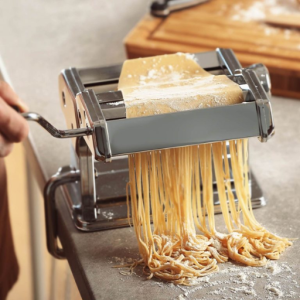
When selecting a pasta maker, consider the following points to ensure you have chosen the right one for your culinary needs. First, take into account how often you will use it. If you plan on making pasta regularly, an electric model may be more suitable than a manual one because it saves time and effort. Second, think about what types of pasta you want to produce. Some machines come with various attachments for different shapes, while others may specialize in certain styles only.
Moreover, check whether there are adjustable thickness settings and if it is easy to clean because these features will improve your overall experience. Finally, consider your budget; though advanced models can cost more money, inexpensive options still exist that give good performance, too. Considering all these things, you can choose a pasta maker that fits perfectly with your cooking routine.
Factors to Consider When Buying a Pasta Machine
- Machine Category: Determine if you want a hand-operated or electric pasta maker. Manual machines are usually cheaper but require more effort, whereas electric ones can handle larger quantities and more intricate shapes.
- Build Quality: Look for models constructed from strong materials such as stainless steel, which can withstand a beating and be cleaned easily. A well-built machine will perform better and last longer.
- Variety: Look at machines with many different attachments for making various types of pasta or those that let you adjust thickness settings. This allows for more experimentation with different styles and sizes of pasta.
- Ease of Use/Cleaning: Read reviews specifically about how easy the machine is to use – especially if you’re new to this – and clean; ideally, it should be simple enough to figure out without instructions. Also, if it’s easy to disassemble (without tools), cleaning becomes much less hassle!
- Price/Warranty: Decide roughly what your budget is and try to find something that balances features against cost well. You may also want peace of mind in terms of durability/reliability, which comes with some manufacturers offering longer warranties than others.
Remember these points when purchasing a pasta machine to complement your cooking style!
Pasta Maker Attachments for Mixers
Mixer pasta maker attachments are created to make the pasta-making process easier by being compatible with your existing stand mixer. These accessories often come with a dough flattener and different cutters for creating various types of pasta, like fettuccine or spaghetti. If you have a mixer already, this is great because it allows for less clutter on your countertop and more efficient workflow. Brands such as KitchenAid and Bosch are popular choices that offer durable attachments which can help in making fresh pasta at home quickly. It is essential to ensure that the attachment will fit onto your specific mixer model before purchasing one; additionally, some models may have multiple speed settings or adjustable thicknesses, allowing for more customization when making pasta with an attachment.
Where to Buy the Best Pasta Maker
To locate the best pasta maker, visit these websites:
- Amazon: This website has various pasta makers, including manual devices and electric models. It is easy to use and has numerous customer reviews and ratings for comparison purposes of various brands and prices. Besides, you can benefit from competitive pricing and fast delivery.
- Williams Sonoma: If you want quality kitchenware, this is the place to go. They offer only high-end pasta-making machines. They also provide detailed product descriptions and reviews, which are helpful in making decisions on what kind of machine to buy. Shopping here will suit those who need premium features from reliable brands.
- Bed Bath and Beyond: You can find many different types of pasta makers on this website at various price points, including popular brands. Moreover, coupon options are available so customers can save money when purchasing their desired item(s). In addition, people have the option of in-store pickup, which makes it convenient since they would not have to wait long before obtaining their new pasta maker.
These three sites should be enough to help you start your search for a pasta maker that fits within your budget and meets all of your needs.
Making Gourmet Pasta at Home
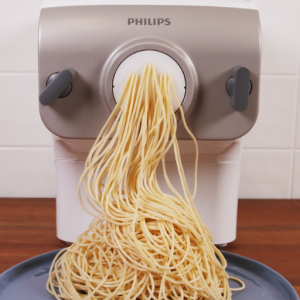
To cook gourmet pasta at one’s own house, it is suggested that you use top-notch flour such as semolina or Tipo 00 for the best texture. Combine the flour with fresh eggs in a ratio of about one egg to every 100 grams of flour and knead until smooth and elastic. Allow the dough to rest for at least half an hour before rolling it out to your desired thickness using a pasta maker. Cut shapes into the pasta if you prefer tagliatelle, lasagna sheets, or ravioli. Finally, boil salted water and cook the pasta for two to four minutes, depending on thickness, then toss it with the sauce of choice for delicious homemade meals. Have fun experimenting with sauces and fillings to make your pasta more exciting!
Essential Pasta Making Tips
- Flour Choice: To achieve perfect pasta texture, use high-protein flours like semolina or Tipo 00; these will give you firmer noodles that hold their shape during boiling.
- Knead It Well: Knead your dough for at least ten minutes so that the gluten can develop and make your pasta elastic and strong.
- Let It Rest: After kneading, allow your dough to rest for at least thirty minutes; this step is important as it lets the gluten relax, which makes rolling easier later on.
- Roll Evenly: When using a pasta maker machine, start with the widest setting and work down to the desired thickness gradually. This prevents tearing while ensuring uniform thickness throughout.
- It’s All About Flouring: While rolling and cutting, dust both sides of pasta sheets and the working surface liberally with flour to prevent sticking. An even light coating aids manageability throughout.
- Cook al dente: Boil fresh noodles in salted water, but check doneness frequently because they usually take significantly less time than dried ones; aim for tenderness with some bite left.
- Mix-Up Sauces: There is no limit to what sauces one can try with homemade noodles. For instance, plain olive oil and garlic could be used to bring out their freshness, or alternatively, marinara/Alfredo can be employed when serving heavier dishes.
With these few steps, you will not only become better at making pasta but also wow your loved ones!
Creating Various Pasta Shapes
Different pasta shapes provide different textures and the ability to hold sauces. Below are some commonly used types of pasta and ways of making them:
- Tagliatelle: This long, flat, ribbon-like pasta is made by rolling the dough into thin sheets and cutting it into strips about 1/4 inch wide. It pairs well with heavy sauces such as bolognese sauce.
- Farfalle: Also known as bowtie pasta, farfalle is created by cutting rolled-out dough into rectangles and then pinching the center together. The shape helps chunky sauces stick to it more efficiently and is frequently used in making pasta and salads.
- Ravioli: To make ravioli, roll out the dough until very thin sheets form. Then, place tiny heaps of filling onto one sheet before folding it over and cutting it into squares that tightly seal the edges around the fillings. Different ingredients, such as cheese, spinach, or meat mixtures, can be used for fillings.
- Tortellini: Tortellini resemble ravioli, except they are shaped like rings; thus, you cut circles out of the pasta, stuff them at the center with fillings and fold corners together, which gives a ring appearance afterward. This shape is traditionally served either in broth or alongside sauce.
A little bit of practice and trying out various recipes will enable you to easily create these different textures when preparing your meals so that they match up well with their accompanying sauces, which complement each other’s unique flavors.
Stuffed and Filled Pasta Varieties
Different flavors and textures can be explored in pasta recipes with stuffed and filled pasta types. Here are a few of them:
- Cannelloni: Big pasta tubes stuffed usually with spinach, ricotta cheese, and herbs, then baked in béchamel sauce or a rich tomato. This dish gets more flavors during the baking process and becomes more comforting.
- Manicotti: Manicotti is similar to cannelloni as it is also broad tube-like pasta filled with the same fillings. However, many people prefer to layer them up in a baking dish before baking until they are bubbly on top, and some sauce covers them underneath. Others just want cheese over their tops, which will make them brown nicely when done this way, too!
- Stuffed Shells: Jumbo-sized Pasta shells are filled with various combinations, like mozzarella cheese alongside ricotta and spinach, before being baked inside marinara sauce. This pasta allows for easy meal prep since it can be assembled earlier and then cooked later once ready for serving.
You can use any type of filling you want in each variety, and sauces may also vary greatly, providing endless creativity when cooking filled or stuffed pasta.
Frequently Asked Questions (FAQs)
Q: What is the best electric pasta maker for home use 2024?
A: The best electric pasta maker for home use in 2024 is often cited as the Philips Pasta and Noodle Maker. It features easy operation and quick pasta-making capabilities and comes highly recommended by America’s Test Kitchen.
Q: How does the Marcato Atlas 150 Pasta Machine compare to other pasta makers?
A: The Marcato Atlas 150 Pasta Machine is widely regarded for its durability and high-quality construction. Unlike many electric machines, it allows for greater control over dough thickness and is perfect for making sheets of pasta and various pasta shapes. It is considered one of the best manual pasta maker options.
Q: What are the benefits of using a pasta maker machine instead of buying dry pasta?
A: A pasta maker machine allows you to make fresh pasta dough at home, which typically offers better texture and flavor than dry pasta. Home pasta makers can also help you customize your pasta recipe, allowing for dietary modifications and creating stuffed pasta or unique pasta shapes.
Q: What should I consider when buying a pasta maker?
A: When buying a pasta maker, consider whether you prefer an electric or manual model, the types of pasta you want to make, and the ease of cleaning. For instance, the Atlas 150 Pasta Machine is a great manual model, while the Philips Pasta and Noodle Maker is an excellent electric option. Additionally, check for any included accessories like a pasta drying rack or a 3-piece pasta roller set.
Q: Is there a notable difference between the best electric and manual pasta makers?
A: The main difference lies in ease of use and control. Electric pasta makers, like the Philips Pasta and Noodle Maker, automate the process, making it quicker and often more straightforward. Manual models, like the Marcato Atlas 150 Pasta Machine, offer more control over the dough thickness and consistency but require more effort.
Q: How do I use a pasta maker machine to make pasta at home?
A: To use a pasta maker machine, start with a fresh pasta dough recipe. Roll the dough through the machine to flatten it into sheets of pasta. Then, use the machine’s cutting attachments to create your desired pasta shapes. If needed, allow the pasta to dry on a pasta drying rack. You’ll need additional equipment specific to your pasta maker model for stuffed pasta.
Q: What attachments and accessories are helpful with pasta makers?
A: Useful attachments and accessories include a pasta drying rack for drying fresh pasta, a 3-piece pasta roller for different pasta shapes, and a gourmet pasta press attachment for making short pasta. These additions can help make the process more efficient and versatile.
Q: Can I find a good pasta maker to make pasta and noodles?
A: Yes, many pasta and noodle makers are available, such as the Philips Pasta and Noodle Maker, which includes different shaping discs to make various pasta and noodle types. The versatility of these machines makes them great for home use, allowing you to enjoy fresh, homemade pasta and noodles.
Q: How are the pasta makers tested to determine the best ones?
A: Pasta makers are tested based on several factors, including ease of use, consistency of the pasta produced, the range of pasta shapes they can make, and the overall quality of construction. Test kitchens, like America’s Test Kitchen, often perform these tests rigorously to help you find the best pasta makers available.












